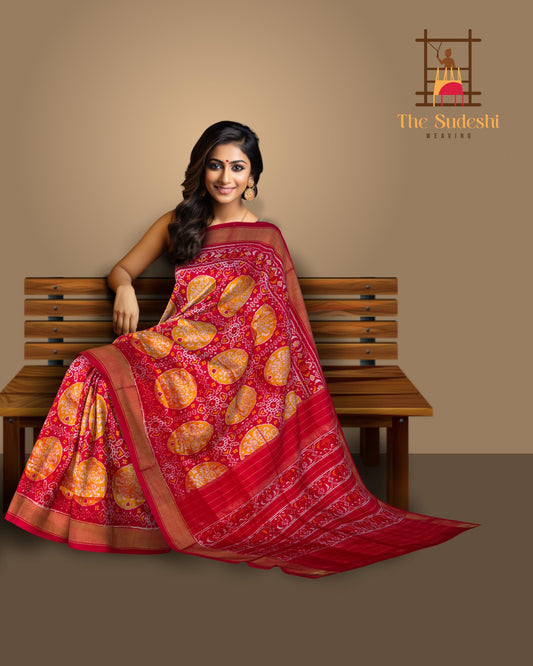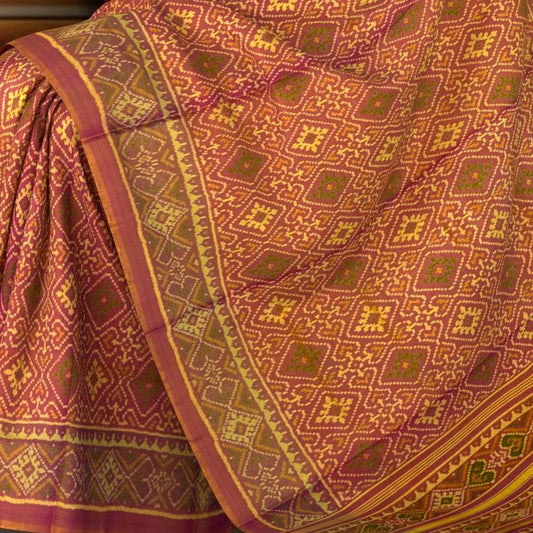The Timeless Elegance of Patola Sarees: A Journey Through Indian Cinema and Television
Patola sarees, renowned for their intricate designs and vibrant colors, have long been a symbol of luxury and heritage in Indian culture. Originating from Patan in Gujarat, these sarees are not just pieces of clothing; they are a representation of the rich cultural tapestry of India. Over the years, Patola sarees have made their way from traditional wardrobes to the silver screen, becoming iconic symbols in Indian cinema and television. This blog explores the representation of Patola sarees in Indian films and TV shows, highlighting the iconic scenes that have immortalized these sarees in popular culture.
The Allure of Patola Sarees in Cinema
Indian cinema has always been a reflection of the country’s diverse culture and traditions. In this vibrant tapestry, Patola sarees have played a significant role, adding a touch of elegance and authenticity to the characters who wear them. Whether it's in period dramas or contemporary settings, Patola sarees have been used by filmmakers to convey various emotions and cultural nuances.
Iconic Moments in Films
-
The Regal Presence in "Bajirao Mastani"
Sanjay Leela Bhansali’s epic historical romance, Bajirao Mastani, is a visual feast, where every costume is meticulously crafted to reflect the era it portrays. In the film, Deepika Padukone's character, Mastani, is seen draped in a Patola saree during some of the most pivotal scenes. The rich colors and intricate designs of the saree enhance her regal presence, symbolizing her strength and resilience as a warrior princess. -
Cultural Significance in "Devdas"
Another Bhansali classic, Devdas, showcases the grandeur of Indian culture through its costumes. Aishwarya Rai Bachchan, who plays the character Paro, dons a Patola saree in one of the film’s most memorable scenes. The saree not only enhances her beauty but also serves as a nod to her character's cultural roots, adding depth to her portrayal of a traditional Bengali woman. -
Timeless Beauty in "Ram-Leela"
In the vibrant and passionate world of Goliyon Ki Raasleela Ram-Leela, Patola sarees make a significant appearance. Deepika Padukone, once again, is seen wearing a Patola saree in the song "Lahu Munh Lag Gaya," where the saree’s bright hues and elaborate patterns perfectly match the festive and energetic mood of the scene. The saree becomes a part of the narrative, symbolizing the colorful yet tumultuous love story at the heart of the film.
Patola Sarees on Television: A Reflection of Tradition
Television, with its vast reach and influence, has also played a crucial role in bringing Patola sarees into the limelight. Daily soaps and historical dramas alike have used these sarees to enhance the authenticity of the characters and settings.
Memorable Appearances in TV Shows
-
"Yeh Rishta Kya Kehlata Hai"
This long-running television drama has seen its characters donning various traditional attires over the years, and Patola sarees have been a recurring favorite. The sarees are often used in wedding sequences or during festivals, emphasizing the cultural heritage of the characters. The detailed craftsmanship of the Patola sarees complements the show’s focus on family values and traditions. -
"Balika Vadhu"
In the iconic show Balika Vadhu, which explores the complexities of rural life in India, Patola sarees have been used to represent the rich cultural heritage of the Gujarati community. The sarees are worn by key characters during significant moments, symbolizing the transition from tradition to modernity that the show so poignantly depicts. -
"Mahabharat"
In various adaptations of the epic Mahabharat on Indian television, Patola sarees have been used to depict the royal elegance of female characters such as Draupadi and Kunti. The sarees, with their intricate patterns, reflect the grandeur and complexity of the characters, adding a layer of authenticity to the historical narrative.
Influence on Popular Culture
The influence of Patola sarees extends beyond the screen, impacting fashion trends and popular culture in significant ways. The depiction of these sarees in films and TV shows has sparked renewed interest in traditional Indian textiles, leading to a resurgence in their popularity among modern consumers.
Revival of Traditional Weaving
The spotlight on Patola sarees in media has contributed to a revival of the traditional art of Patola weaving. Artisans who specialize in this craft have seen a surge in demand, as more people seek to own a piece of this cultural heritage. The media’s portrayal of these sarees has not only increased their commercial value but also brought recognition to the weavers who painstakingly create these masterpieces.
Patola Sarees in Modern Fashion
Fashion designers have taken inspiration from the representation of Patola sarees in cinema and television, incorporating the traditional patterns and motifs into contemporary designs. This fusion of tradition and modernity has led to the creation of Patola-inspired dresses, lehengas, and even accessories, making the timeless beauty of these sarees accessible to a wider audience.
Conclusion
Patola sarees, with their rich history and cultural significance, have found a cherished place in Indian cinema and television. The depiction of these sarees in iconic scenes has not only enhanced the visual appeal of the characters but also brought the art of Patola weaving into the global spotlight. As they continue to influence fashion and popular culture, Patola sarees remain a testament to India’s enduring legacy of craftsmanship and tradition. Whether on screen or in real life, the allure of Patola sarees is truly timeless, weaving together the threads of history, culture, and artistry in every drape.







Leave a comment
Please note, comments need to be approved before they are published.